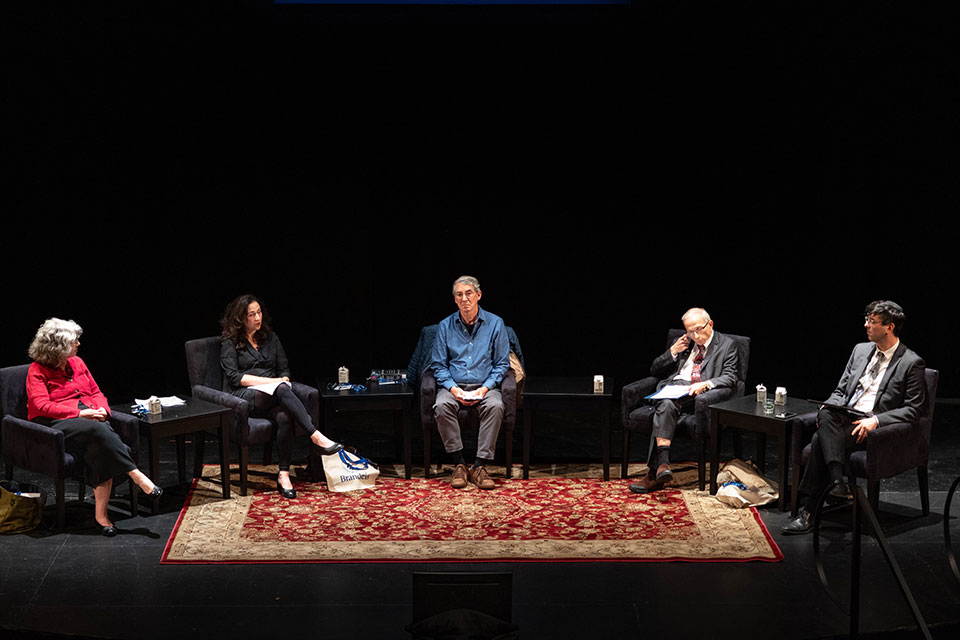The Power of Brandeis Science

By Laura Gardner
Photography by Dan Holmes and Gaelen Morse
October 16, 2023
Since its earliest days, Brandeis has played an outsized role in advancing science, attracting and developing world-class faculty, educating top-notch scientists, and producing game-changing breakthroughs.
How did a university that’s so much smaller and younger than its competitors come to achieve such scientific prowess? Two panel discussions held during the 75th anniversary weekend celebration shed light on that basic question.
In fields ranging from biology and chemistry to physics and mathematics, the panelists, whether early-, mid-, or late-career scientists, said the university’s bedrock culture of collaboration, community and mentorship helped them explore new areas of research and advance scientific understanding.
“Trailblazing Women Scientists at Brandeis” featured Ruth Charney ’72, GSAS MA’72, the Theodore and Evelyn G. Berenson Professor of Mathematics, Emerita; Christine Grienberger, assistant professor of biology; chemist Grace Han, Landsman Career Development Chair of Science; Liz Hedstrom, professor of biology and chemistry; and Gabriella Sciolla, professor of physics.


The Saturday panel, “Groundbreakers, Game Changers and Education” featured Nobel laureate Michael Rosbash, the Peter Gruber Endowed Chair in Neuroscience and Howard Hughes Medical Institute Investigator; James Haber, the Abraham and Etta Goodman Professor of Biology and Director, Rosenstiel Basic Medical Sciences Research Center; Gina Turrigiano, the Joseph Levitan Professor of Vision Science; Dorothee Kern, Professor of Biochemistry and Howard Hughes Medical Institute Investigator; and Eve Marder ’69, University Professor and Victor and Gwendolyn Beinfield Professor of Neuroscience.
Rosbash, who was awarded the Nobel Prize in 2017 for his research on circadian rhythms, noted key elements that make Brandeis a scientific powerhouse. “Excellent institutions have a positive feedback loop. Excellent people insist on hiring other excellent people, and that leads to the persistence of an excellent institution.
“Another explanation is that there’s wonderful, remarkable collaboration between different groups and different disciplines,” he said, adding “we have wonderful colleagues and a community which we so value.”
Charney, who moderated Friday’s panel, described her own experience as a professor at The Ohio State University, where she taught for two decades before coming to Brandeis. At Ohio State, it was “years and years” before she met anyone outside of the mathematics department. At Brandeis, she immediately started to get to know people across the university, she said.
“Excellent institutions have a positive feedback loop. Excellent people insist on hiring other excellent people, and that leads to the persistence of an excellent institution.”
Michael Rosbash
Marder, who returned to Brandeis as a young faculty member in 1978 after earning a doctorate at the University of California, San Diego, said she benefited from Brandeis’ institutional “open mindedness.” She was the fifth woman hired in a biology department of 16, “which is really remarkable,” she said. “All of my female peers who went off to other institutions were usually the first.”


Turrigiano, who was once a postdoc in Marder’s lab, described Brandeis as an “incredibly collaborative, interactive place,” characterized by “a rich web of connectivity,” with undergraduates, grad students, postdocs and faculty interacting with one another.
Echoing other panelists, Kern said Brandeis is able to identify quirky, “kind of crazy” people — interesting scientists who want to do something novel and help advance a field before it is labeled “sexy.”
In Friday’s panel, Hedstrom noted, “There’s a theory out there that Brandeis has always been opportunistic, and taken up people who are undervalued. You find the group of people who aren’t getting their due, and you give them a chance. Not only do they thrive, but they’re very loyal to the university.”
Grienberger, who recently won a $1.5 million National Institutes of Health New Innovator Award, cited the “giants” who paved the way for her success, including Turrigiano, Rosbash and the late Brandeis biologist, John Lisman.

The panelists mentioned Brandeis’ ability to foster intellectual and personal self-confidence. “One of the things that really makes Brandeis special is the collaboration. There is somebody here who will help you with whatever wacky idea you have,” said Hedstrom.
Even though there were no women on the math faculty when Charney was an undergraduate at Brandeis, she said she was encouraged to go to graduate school. “The faculty were thrilled that we were excited about mathematics.”
Linda Zimmerman ’69, who attended the Friday panel discussion, offered her own take on Brandeis’ approach to science: “Nothing was beyond imagination.”




